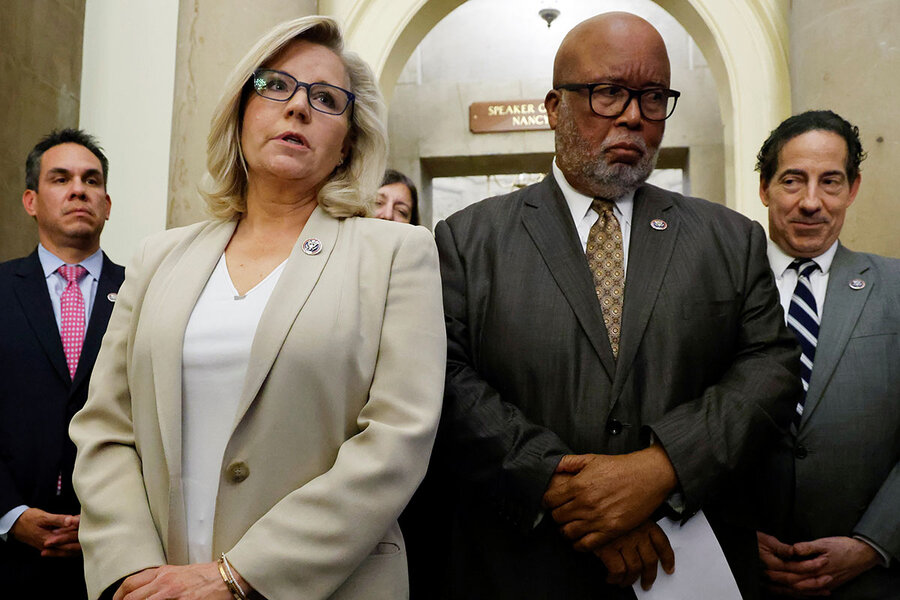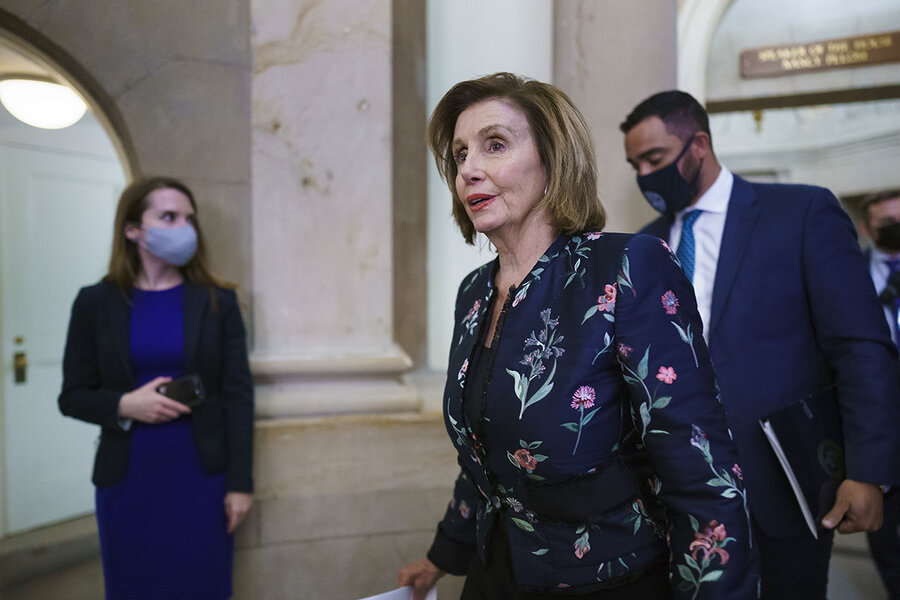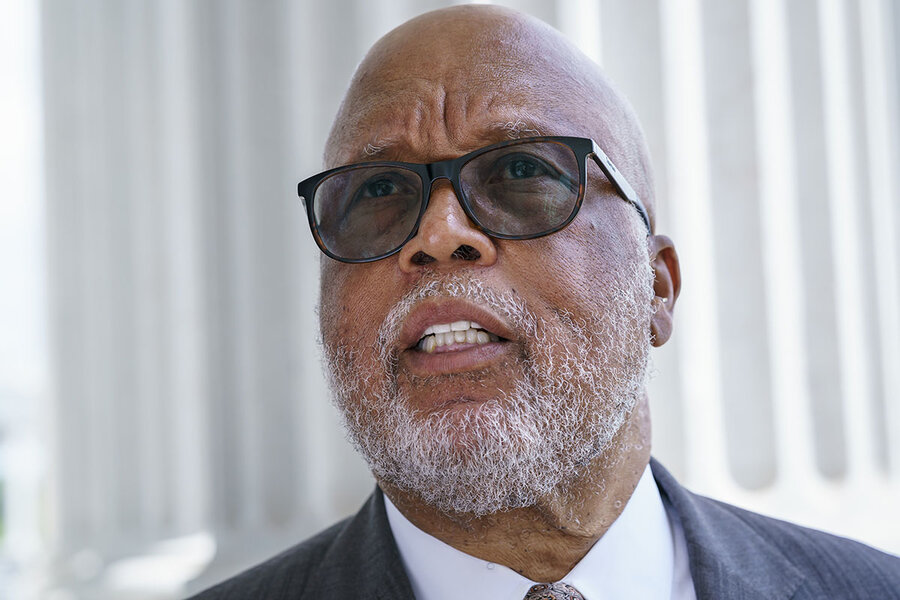As Congress launches new Jan. 6 inquiry, a push for the truth
Loading...
| Washington
Democrats and Republicans both say they want to uncover the whole truth about the Jan. 6 attack on the U.S. Capitol. But, to varying degrees, they’re resisting lines of inquiry that might challenge their narratives about the events of that day. Each side is accusing the other of acting to protect their political interests – reflecting a significant national divide.
Democrats, and even some Republicans, accuse the GOP of being unserious about investigating the events of Jan. 6, given that they have refused to implicate former President Donald Trump and his “Stop the Steal” messaging. Republicans, for their part, have characterized Democrats’ inquiries as the latest chapter in a long-running “witch hunt” against Mr. Trump, and have faulted them for not being willing to examine whether last summer’s Black Lives Matter protests contributed to an atmosphere ripe for political violence.
Why We Wrote This
Is it possible to get to the bottom of an intensely political event without being political?
On Tuesday, a new House select committee will hold its first hearing on the matter, but GOP leadership has boycotted the committee after Speaker Nancy Pelosi vetoed two of their appointees.
“We have to get it right,” said Chairman Bennie Thompson, a Mississippi Democrat.
More than six months after rioters disrupted Congress’ certification of the 2020 election results, many questions remain about the worst breach of the United States Capitol in more than 200 years.
Lawmakers will seek to start filling in those remaining holes Tuesday, when the House of Representatives launches a new Jan. 6 investigation.
Both Democrats and Republicans say they want to uncover the whole truth. But, to varying degrees, they are resisting lines of inquiry that could challenge or complicate their narratives about the events of that day and its causes.
Why We Wrote This
Is it possible to get to the bottom of an intensely political event without being political?
Democrats, and even some Republicans, blame the GOP for being unserious about investigating the events of Jan. 6, given that they have refused to implicate former President Donald Trump and his “Stop the Steal” messaging. Two-thirds of House Republicans voted against certifying the 2020 election results when they reconvened after the assault – a move critics say puts them in a sympathetic camp with the rioters themselves.
Republicans, for their part, accuse Democrats of resisting inquiries into House Speaker Nancy Pelosi’s discussions with security officials ahead of Jan. 6 that may have shaped the Capitol Police’s approach that day. They characterize Democrats’ inquiries into Jan. 6 as the latest chapter in a long-running “witch hunt” against Mr. Trump, and say exercising a constitutional provision to challenge election results – which Democrats have also used in recent years – is far different than engaging in violence. They also have pushed for any inquiry to examine whether last summer’s Black Lives Matter protests contributed to an atmosphere ripe for political violence.
In May, Senate Republicans blocked the creation of a bipartisan independent commission, whose findings would likely have had a better shot at being seen as credible by both sides than the new select committee to investigate the Jan. 6 attack. Last week, Speaker Pelosi took the unusual step of vetoing two of the GOP’s five picks, saying they would undermine the committee’s integrity. Both are ardent Trump supporters who voted against certifying the 2020 election results, and one – Ohio Rep. Jim Jordan – may be a material witness to the events leading up to that day. Both he and GOP Minority Leader Kevin McCarthy spoke with Mr. Trump on Jan. 6 and, if called to testify, could fill in gaps about the president’s willingness to intervene after rioters in pro-Trump gear breached the Capitol and clashed with police officers, 140 of whom were injured and three of whom later died. Four Trump supporters also died, including one who was shot by a Capitol police officer.
In response, Mr. McCarthy pulled his three other appointees, calling the investigation a sham. He says he will launch a separate, GOP-run inquiry, which is expected to delve into why there was not a more robust security plan in place. However, without subpoena power, it is unclear how much new information they will be able to gather.
The select committee is now moving ahead with nine members appointed by Speaker Pelosi, including Republican Reps. Liz Cheney of Wyoming and Adam Kinzinger of Illinois. Both are vocal Trump critics who voted to impeach the president after he encouraged his followers to march to the Capitol on Jan. 6, where Congress was meeting to certify Joe Biden’s 306-232 Electoral College win.
Efforts to investigate Jan. 6 so far
Several fact-finding reports on the events of that day have already been issued. Speaker Pelosi tasked Lt. Gen. Russel L. Honoré, a retired Army veteran, with conducting a review of Capitol security. His March report noted a number of vulnerabilities – including a Capitol Police personnel shortage of 233 officers, which has led to many officers working overtime and rarely having the opportunity to engage in training, which is essential for preparing for riot response.
U.S. Capitol Police have been sounding the alarm on inadequate training for years. In 2019, USCP union chairman Gus Papathanasiou testified that officers were only allowed to train at the Capitol Hill firing range, which was open only a few days a month. In addition, he noted that a three-day active shooter training had been reduced to just one day.
Yet the Capitol Police budget has grown significantly in recent years to $515 million – larger than that of some metropolitan police departments, and just $40 million less than Washington, D.C.’s, which has more than twice as many sworn officers and a far larger jurisdiction.
That statistic was included in a 95-page bipartisan report released in June from the Senate’s Rules and Homeland Security committees, based on thousands of pages of documents, firsthand accounts from more than 50 Capitol Police members, and interviews with key decision-makers from the FBI, National Guard, and Congress.
“Does anybody have a plan?” the report noted a lieutenant repeatedly asked over the radio as the attack unfolded. The answer to that question: not really.
The report outlined recommendations for addressing a number of failures, including federal intelligence agencies not issuing warnings despite known threats, inadequate preparation by the Capitol Police, and bureaucratic hurdles that delayed deployment of the National Guard for more than three hours after the Capitol was breached.
Capitol Police assessed the potential for violence around Jan. 6 in mid-December, with a deputy chief warning that it “will bring some demonstrations, with the potential for some issues on the House floor.” But leadership concluded there were no specific threats to the joint session. After then-President Trump tweeted on Dec. 19, “Big protest in D.C. on January 6th. Be there, will be wild!” the District of Columbia’s Metropolitan Police Department sent an email to law enforcement partners, including the Capitol Police, anticipating a protest on par with two previous pro-Trump gatherings in November and December.
The FBI did not issue a formal intelligence assessment ahead of Jan. 6, but it did share a Jan. 5 report from a local FBI office in Norfolk, Virginia, warning of online threats of violence. It highlighted in particular a thread that read in part, “Be Ready to Fight. Congress needs to hear glass breaking, doors being kicked in. ... Stop calling this a march, or rally, or a protest. Go there ready for war.” The report was shared with law enforcement partners at 7:37 p.m. on Jan. 5.
The Capitol Police’s internal intelligence unit issued contradictory information leading up to the event, with a Jan. 3 assessment warning of violence but the daily bulletin categorizing the likelihood of civil disturbance as “remote” to “improbable.” There was no department-wide operational plan, and only about 160 of the 1,840 sworn officers were trained in responding to civil disturbance. Of those, fewer than 10 were “trained to use USCP’s full suite of less-than-lethal munitions.”
Meanwhile, the Department of Defense issued two memos on Jan. 4 and 5 that strictly controlled the use of the National Guard, including deploying a Quick Reaction Force only as a last resort. These strictures contributed to the delay in deploying the National Guard on Jan. 6.
The bipartisan report concluded that the DOD’s response was shaped by the harsh criticism it had received for its response to Black Lives Matter protests in Washington over the summer, including the use of military helicopters. With those lessons in mind, it sought “to avoid the appearance of overmilitarization” in responding on Jan. 6.
The worst breach in 200 years
Before Vice President Mike Pence had even gaveled in the joint session of Congress to certify the Electoral College results on Jan. 6, a huge crowd had left then-President Trump’s “Save America” rally in front of the White House and overrun barriers on the edge of the Capitol complex. Just over an hour later, they breached the Capitol itself. As Mr. Pence was whisked into hiding, a quick-thinking Capitol Police officer led a group of Trump supporters away from an unguarded entrance to the Senate chamber, where debate about whether to object to the results of Arizona’s election had been abruptly cut off.
Most lawmakers were evacuated, but some, along with many staffers, were left huddling behind office doors as more than 800 people, some yelling that they wanted to “hang” Mr. Pence or hunt for Speaker Pelosi, streamed through the halls of Congress. More than 540 people have been charged by federal prosecutors in more than 40 states so far, according to a USA Today tally, including 16 who have pleaded guilty.
Capitol Police appeared to be in disarray, calling for reinforcements but struggling to integrate them into existing units and lacking overall direction from their leadership, according to the bipartisan Senate report. According to existing protocols, the Capitol Police chief could not personally activate the National Guard, but was required to submit a written request to the Capitol Police Board, made up of the House Sergeant at Arms, the Senate Sergeant at Arms, and the Architect of the Capitol. However, none of the members of the board appeared clear on how exactly the process was supposed to work, especially during an emergency, including whether such a request required unanimous or simply majority approval.
Former USCP Chief Steven Sund testified before the joint committee in the Senate that on Jan. 4 he had met with Paul Irving, then House sergeant-at-arms, and requested that the Capitol Police Board declare an emergency and authorize the National Guard to provide assistance. He said Mr. Irving raised concerns about the “optics” of having National Guard troops at the Capitol during a protest – a characterization Mr. Irving denied in his own testimony, saying that he and his colleagues determined the intelligence did not warrant bringing in troops. Mr. Sund said he also made the same request of Michael Stenger, then Senate sergeant-at-arms, who denied the request.
Mr. Irving reports to Speaker Pelosi, while Mr. Stenger reported at the time to then-Senate Majority Leader Mitch McConnell, before Democrats won control of that chamber. Four top GOP lawmakers wrote Ms. Pelosi in February, asking pointed questions about why Mr. Sund’s Jan. 4 request for National Guard assistance was denied and whether her office had given any instructions related to that or his subsequent request on Jan. 6. Two of those representatives – Rodney Davis and Jim Jordan – were among the five members Mr. McCarthy recently appointed to the select committee.
Ms. Pelosi’s office has pushed back against such inquiries. “On January 6th, the Speaker – a target of an assassination attempt that day – was no more in charge of Capitol security than Mitch McConnell was. This is a clear attempt to whitewash what happened on January 6th and divert blame,” Drew Hammill, a spokesperson for Ms. Pelosi, told The Associated Press.
The select committee’s work
The select committee is chaired by Rep. Bennie Thompson of Mississippi, a 14-term congressman and the sole Democrat from his state’s congressional delegation, who has a history of bipartisan cooperation. He chairs the House Homeland Security Committee, which he has served on since 2005. Critics have noted that he voted against the certification of George W. Bush’s 2004 election in Ohio, along with 30 other Democrats.
Also on the select committee are Adam Schiff and Jamie Raskin, the respective managers of the first and second impeachment trials of Mr. Trump, who hail from California and Maryland; Californians Zoe Lofgren and Pete Aguilar, chairwoman and member, respectively, of the House Administration Committee, which oversees the U.S. Capitol Police; former national security specialist Stephanie Murphy of Florida; former naval commander Elaine Luria of Virginia; and Ms. Cheney and Mr. Kinzinger.
As the committee holds its first hearing Tuesday with law enforcement personnel, key questions still remain. While earlier fact-finding investigations focused on security lapses at the Capitol, this probe is likely to delve much more into Mr. Trump’s rhetoric leading up to and on Jan. 6. It will also look at those who participated in the events of the day, including those who organized, trained, and funded the participants who came prepared to breach the Capitol.
“We have to get it right,” said Chairman Thompson, who was among a group of representatives told by police to duck under their seats as Trump supporters tried to enter the House chamber. If his committee could help prevent another such attack, he said, “then I would have made what I think is the most valuable contribution to this great democracy.”










